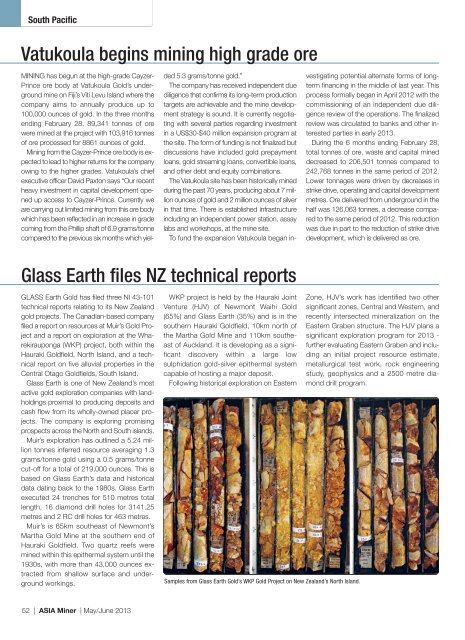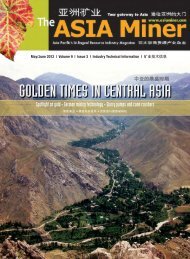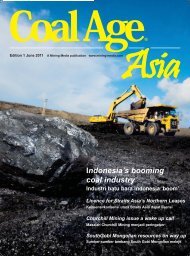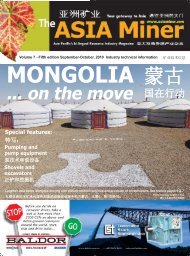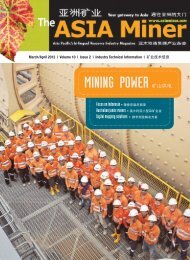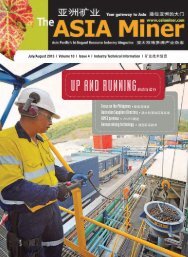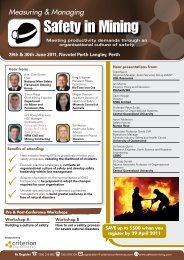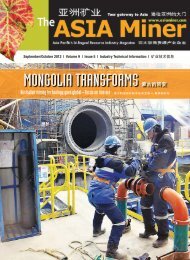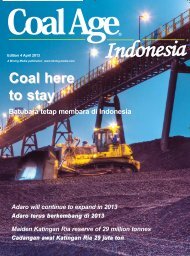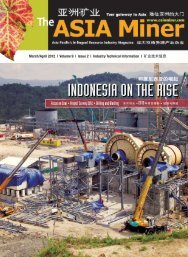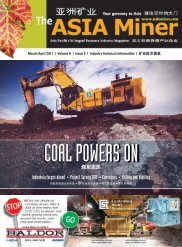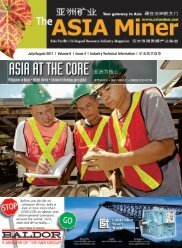May/June 2013 - The ASIA Miner
May/June 2013 - The ASIA Miner
May/June 2013 - The ASIA Miner
Create successful ePaper yourself
Turn your PDF publications into a flip-book with our unique Google optimized e-Paper software.
South Pacific<br />
Vatukoula begins mining high grade ore<br />
MINING has begun at the high-grade Cayzer-<br />
Prince ore body at Vatukoula Gold’s underground<br />
mine on Fiji’s Viti Levu Island where the<br />
company aims to annually produce up to<br />
100,000 ounces of gold. In the three months<br />
ending February 28, 89,341 tonnes of ore<br />
were mined at the project with 103,916 tonnes<br />
of ore processed for 8861 ounces of gold.<br />
Mining from the Cayzer-Prince ore body is expected<br />
to lead to higher returns for the company<br />
owing to the higher grades. Vatukoula’s chief<br />
executive officer David Paxton says “Our recent<br />
heavy investment in capital development opened<br />
up access to Cayzer-Prince. Currently we<br />
are carrying out limited mining from this ore body<br />
which has been reflected in an increase in grade<br />
coming from the Phillip shaft of 6.9 grams/tonne<br />
compared to the previous six months which yielded<br />
5.3 grams/tonne gold.”<br />
<strong>The</strong> company has received independent due<br />
diligence that confirms its long-term production<br />
targets are achievable and the mine development<br />
strategy is sound. It is currently negotiating<br />
with several parties regarding investment<br />
in a US$30-$40 million expansion program at<br />
the site. <strong>The</strong> form of funding is not finalized but<br />
discussions have included gold prepayment<br />
loans, gold streaming loans, convertible loans,<br />
and other debt and equity combinations.<br />
<strong>The</strong> Vatukoula site has been historically mined<br />
during the past 70 years, producing about 7 million<br />
ounces of gold and 2 million ounces of silver<br />
in that time. <strong>The</strong>re is established infrastructure<br />
including an independent power station, assay<br />
labs and workshops, at the mine site.<br />
To fund the expansion Vatukoula began investigating<br />
potential alternate forms of longterm<br />
financing in the middle of last year. This<br />
process formally began in April 2012 with the<br />
commissioning of an independent due diligence<br />
review of the operations. <strong>The</strong> finalized<br />
review was circulated to banks and other interested<br />
parties in early <strong>2013</strong>.<br />
During the 6 months ending February 28,<br />
total tonnes of ore, waste and capital mined<br />
decreased to 206,501 tonnes compared to<br />
242,768 tonnes in the same period of 2012.<br />
Lower tonnages were driven by decreases in<br />
strike drive, operating and capital development<br />
metres. Ore delivered from underground in the<br />
half was 126,063 tonnes, a decrease compared<br />
to the same period of 2012. This reduction<br />
was due in part to the reduction of strike drive<br />
development, which is delivered as ore.<br />
Glass Earth files NZ technical reports<br />
GLASS Earth Gold has filed three NI 43-101<br />
technical reports relating to its New Zealand<br />
gold projects. <strong>The</strong> Canadian-based company<br />
filed a report on resources at Muir’s Gold Project<br />
and a report on exploration at the Wharekirauponga<br />
(WKP) project, both within the<br />
Hauraki Goldfield, North Island, and a technical<br />
report on five alluvial properties in the<br />
Central Otago Goldfields, South Island.<br />
Glass Earth is one of New Zealand’s most<br />
active gold exploration companies with landholdings<br />
proximal to producing deposits and<br />
cash flow from its wholly-owned placer projects.<br />
<strong>The</strong> company is exploring promising<br />
prospects across the North and South islands.<br />
Muir’s exploration has outlined a 5.24 million<br />
tonnes inferred resource averaging 1.3<br />
grams/tonne gold using a 0.5 grams/tonne<br />
cut-off for a total of 219,000 ounces. This is<br />
based on Glass Earth’s data and historical<br />
data dating back to the 1980s. Glass Earth<br />
executed 24 trenches for 510 metres total<br />
length, 16 diamond drill holes for 3141.25<br />
metres and 2 RC drill holes for 463 metres.<br />
Muir’s is 65km southeast of Newmont’s<br />
Martha Gold Mine at the southern end of<br />
Hauraki Goldfield. Two quartz reefs were<br />
mined within this epithermal system until the<br />
1930s, with more than 43,000 ounces extracted<br />
from shallow surface and underground<br />
workings.<br />
WKP project is held by the Hauraki Joint<br />
Venture (HJV) of Newmont Waihi Gold<br />
(65%) and Glass Earth (35%) and is in the<br />
southern Hauraki Goldfield, 10km north of<br />
the Martha Gold Mine and 110km southeast<br />
of Auckland. It is developing as a significant<br />
discovery within a large low<br />
sulphidation gold-silver epithermal system<br />
capable of hosting a major deposit.<br />
Following historical exploration on Eastern<br />
Samples from Glass Earth Gold’s WKP Gold Project on New Zealand’s North Island.<br />
Zone, HJV’s work has identified two other<br />
significant zones, Central and Western, and<br />
recently intersected mineralization on the<br />
Eastern Graben structure. <strong>The</strong> HJV plans a<br />
significant exploration program for <strong>2013</strong> -<br />
further evaluating Eastern Graben and including<br />
an initial project resource estimate,<br />
metallurgical test work, rock engineering<br />
study, geophysics and a 2500 metre diamond<br />
drill program.<br />
52 | <strong>ASIA</strong> <strong>Miner</strong> | <strong>May</strong>/<strong>June</strong> <strong>2013</strong>


